Effects of Climate Change on the Climatic Production Potential of Potatoes in Inner Mongolia, China
Abstract
1. Introduction
2. Materials and Methods
2.1. Study Area
2.2. Data
2.3. Research Methods
2.3.1. Calculation of the Climatic Production Potential
- (1)
- Photosynthetic production potential of potato
- (2)
- Light–temperature production potential of potato
- (3)
- climatic production potential of potato
2.3.2. Impacts of Climate Change on the Climatic Production Potential of Potato
3. Results
3.1. Annual and Interdecadal Variations in the Production Potential of Potato
3.2. Characteristics of the Spatial Distribution of the Potato Production Potential
3.3. Influence of Changes in the Main Meteorological Elements on the Potato Climate Production Potential
3.3.1. The Effect of Radiation Changes on the Potato Climatic Production Potential
3.3.2. Effects of Temperature Changes on the Potato Climatic Production Potential
3.3.3. The Impact of Precipitation Changes on the Climatic Production Potential
4. Discussion
5. Conclusions
Author Contributions
Funding
Data Availability Statement
Acknowledgments
Conflicts of Interest
References
- Li, F.; Zhou, M.J.; Shao, J.Q.; Chen, Z.H.; Wei, X.L.; Yang, J.C. Maize, wheat and rice production potential changes in China under the background of climate change. Agric. Syst. 2020, 182, 102853. [Google Scholar]
- Yuan, B.; Guo, J.P.; Ye, M.Z.; Zhao, J.F. Variety distribution pattern and climatic potential productivity of spring maize in Northeast China under climate change. Chin. Sci. Bull. 2012, 57, 3497–3508. [Google Scholar] [CrossRef][Green Version]
- Jia, Q.; Li, M.F.; Dou, X.C. Climate Change Affects Crop Production Potential in Semi-Arid Regions: A Case Study in Dingxi, Northwest China, in Recent 30 Years. Sustainability 2022, 14, 3578. [Google Scholar] [CrossRef]
- Froehlich, H.E.; Gentry, R.R.; Halpern, B.S. Global change in marine aquaculture production potential under climate change. Nat. Ecol. Evol. 2018, 2, 1745–1750. [Google Scholar] [CrossRef]
- Yang, X.G.; Chen, F.; Lin, X.M.; Liu, Z.J.; Zhang, H.L.; Zhao, J.; Li, K.N.; Ye, Q.; Li, Y.; Lv, S.; et al. Potential benefits of climate change for crop productivity in China. Agric. For. Meteorol. 2015, 208, 76–84. [Google Scholar] [CrossRef]
- David, P.M.Z.; Navin, R.; Carol, C.B.; Jonathan, A.F. From Miami to Madison: Investigating the relationship betweenclimate and terrestrial net primary production. Glob. Biogeochem. Cycles 2007, 21, GB3004. [Google Scholar]
- Liu, H.; Liu, B.; Hua, L.Z.; Shi, Z.J.; Ning, G.F.; Zhang, X. Analysis of temporal and spatial pattern of vegetation NPP in Fujian Province and its driving force. Sci. Surv. Mapp. 2018, 43, 35–44. (In Chinese) [Google Scholar]
- Zhang, X.L.; Xiao, W.H.; Wang, Y.C.; Wang, Y.; Wang, H.J.; Wang, Y.X.; Zhu, L.S.; Yang, R.X. Spatial-temporal changes in NPP and its relationship with climate factors based on sensitivity analysis in the Shiyang River Basin. J. Earth Syst. Sci. 2020, 129, 169–190. [Google Scholar] [CrossRef]
- Chen, T.; Bao, A.M.; Jiapaer, G.L.; Guo, H.; Zheng, G.X.; Jiang, L.L.; Chang, C.; Tuerhanjiang, L. Disentangling the relative impacts of climate change and human activities on arid and semiarid grasslands in Central Asia during 1982–2015. Sci. Total Environ. 2018, 653, 1311–1325. [Google Scholar] [CrossRef]
- Wang, X.F.; Yang, Y.Z.; You, F. Climate change in Heilongjiang Province and its impact on maize production potential. Agric. Res. Arid Areas 2012, 35, 25–29. (In Chinese) [Google Scholar]
- Zhan, T.; Zhong, H.L.; Sun, L.X.; Fischer, G.; Velthuizen, H.V.; Liang, Z. Improving performance of Agro-Ecological Zone (AEZ) modeling by cross-scale model coupling: An application to japonica rice production in Northeast China. Ecol. Model. 2014, 290, 155–164. [Google Scholar]
- Zhang, Y.; Yang, B.; Liu, X.H.; Wang, C.Z. Estimation of rice grain yield from dual-polarization Radarsat-2 SAR data by integrating a rice canopy scattering model and a genetic algorithm. Int. J. Appl. Earth Obs. Geoinf. 2017, 57, 75–85. [Google Scholar] [CrossRef]
- Yu, D.; Hu, S.G.; Tong, L.Y.; Xia, C.; Ran, P.L. Dynamics and Determinants of the Grain Yield Gap in Major Grain-Producing Areas: A Case Study in Hunan Province, China. Food 2022, 11, 1122. [Google Scholar] [CrossRef]
- Wang, Z.M.; Zhang, B.; Zhang, S.Q.; Song, K.S.; Duan, H.T. Research on agroclimatic production potential and utilization rate of natural resources in Songnen Plain. China Agric. Meteorol. 2005, 26, 1–6. (In Chinese) [Google Scholar]
- Li, S.A.; Ju, H.; Chi, B.L. Research progress on crop production potential. China Agric. Meteorol. 2005, 26, 106–111. (In Chinese) [Google Scholar]
- Li, F.; Zhang, S.W.; Zhang, Y.J.; Yang, H.J.; Yang, J.C. Changes of grain production potential in farming–pastoral ecotone: A case study in West Jilin, China. J. Agric. Sci. 2018, 156, 151–161. [Google Scholar] [CrossRef]
- Lu, Y.Y.; Wang, S.; Tian, H.; Deng, H.Q.; He, D.Y. Evolution of climatic production potential and evaluation of climate carrying capacity of food security in Anhui Province in recent 50 years. Resour. Environ. Yangtze River Basin 2017, 26, 428–435. (In Chinese) [Google Scholar]
- Wang, S.; Song, A.W.; Xie, W.S.; Tang, W.A.; Dai, J.; Ding, X.J.; Wu, R. Impact assessment of future climate change on the climatic production potential of rice in the south of Huaihe River in Anhui. Arid Meteorol. 2020, 38, 179–187. (In Chinese) [Google Scholar]
- Wang, S.Y.; Huo, Z.G.; Li, S.K.; Xue, C.Y.; Mao, F. Water deficit and climatic production potential of Winter Wheat in northern China—A Study on dynamic changes in recent 40 years. J. Nat. Disasters 2003, 12, 121–130. (In Chinese) [Google Scholar]
- Duan, X.F.; Qian, H.; Li, J.P.; Ma, G.F.; Yang, Y.; Cao, N.; Zhang, X.Y. Stability analysis of climatic production potential of Jixi potato under 4 sowing dates. Agric. Res. Arid Reg. 2011, 29, 266–271. (In Chinese) [Google Scholar]
- Lai, R.S. Analysis of the Changing Trend of Crop Production Potential and Planting Structure in Ningxia under the Background of Climate Change; Ningxia University: Yinchuan, China, 2016. (In Chinese) [Google Scholar]
- He, Y.N.; Yang, F. Study on background value of environmental soil organic matter in Inner Mongolia Autonomous Region. Inn. Mong. Environ. Prot. 1996, 1, 40–41. (In Chinese) [Google Scholar]
- Xu, S.P.; Tao, S.; Cao, J. Spatial structure characteristics of soil pH value, clay and organic matter content in Inner Mongolia. Soil Bull. 2001, 4, 145–148. (In Chinese) [Google Scholar] [CrossRef]
- Zhang, Y.M.; Liu, Y. Change trend and prediction of cultivated land soil nutrients in Inner Mongolia. Inn. Mong. Agric. Sci. Technol. 2004, 6, 45–46. (In Chinese) [Google Scholar]
- Guo, J.P.; Zhao, J.F.; Wu, D.R.; Mu, J.; Xu, Y.H. Attribution of maize yield increase in China to climate change and technological advancement between 1980 and 2010. J. Meteorol. Res. 2014, 28, 1168–1181. [Google Scholar] [CrossRef]
- Yang, L.T.; Jiang, X.P.; You, L.; Lin, M. Analysis and Evaluation of Potato Climate Suitability in Wuchuan County. Inn. Mongolia. Mod. Agric. 2017, 11, 96–97. (In Chinese) [Google Scholar]
- Jiang, X.P.; Yang, L.T. Study on the Variation of Climate Suitability of Potato in Different Growth Periods–Taking Wuchuan County, Hohhot City as an Example. Int. J. Nat. Resour. Ecol. Manag. 2022, 7, 86–92. [Google Scholar] [CrossRef]
- Ma, Y.L.; Guo, J.P.; Zhao, J.F. Distribution characteristics of crop climate production potential and its response to climate change in the agro-pastoral interlaced zone in northern Shanxi Province. J. Ecol. 2019, 38, 818–827. (In Chinese) [Google Scholar]
- Ma, Y.F.; Li, X.C.; Song, J.H.; Gao, C.X.; Zhao, D.; Shen, Y.B. Climatological calculation of total solar radiation in Inner Mongolia Autonomous Region and its temporal and spatial distribution characteristics. J. Meteorol. Environ. 2013, 29, 102–109. (In Chinese) [Google Scholar]
- Xie, W.Y.; Guo, X.Q.; Lu, D.R.; Yin, Y.C.; Wang, J.B. Analysis of temporal and spatial changes of climatic production potential and hydrothermal factors in the Loess Plateau in Longzhong. Arid Meteorol. 2015, 33, 861–866. (In Chinese) [Google Scholar]
- He, Y.F.; Zhao, M.X.; Wang, J.X.; Zhang, H.S. Response of grassland productivity to climatic factors in the agro-pastoral interlaced zone of Inner Mongolia: Taking Duolun County as an example. Arid Meteorol. 2008, 26, 84–89. (In Chinese) [Google Scholar]
- Liu, Q.; Yan, C.R.; He, W.Q. Research on the production potential of dry farming agroclimate in Shouyang County, Shanxi. China Agric. Meteorol. 2007, 28, 271–274. (In Chinese) [Google Scholar]
- Pang, Y.M.; Chen, C.; Xu, F.X.; Guo, X.Y. Impact of climate change on potential productivities of main grain crops in the Sichuan Basin. Chin. J. Eco-Agric. 2020, 28, 1661–1672. (In Chinese) [Google Scholar]
- Luo, H.P.; Zou, N.; Hu, X.Y.; Wang, S. Climatic potential productivity and resources utilization efficiency of major grain crops in the main grain production areas of China, 1980–2019. Resour. Sci. 2021, 43, 1234–1247. [Google Scholar] [CrossRef]
- Lu, Y.Y.; Sun, W.; Tang, W.A.; He, D.; De, H. Climatic potential productivity and stress risk of winter wheat under the background of climate change in Anhui Province. Chin. J. Eco-Agric. 2020, 28, 17–30. [Google Scholar]
- Wang, Z.M.; Liang, Y.L. The application of EPIC model to calculate crop productive potentialities in Loessic Yuan region. J. Nat. Resour. 2000, 17, 481–487. (In Chinese) [Google Scholar]
- Han, S.; Liu, B.C.; Shi, C.X.; Liu, Y.; Qiu, M.J.; Sun, S. Evaluation of CLDAS and GLDAS Datasets for Near-Surface Air Temperature over Major Land Areas of China. Sustainability 2020, 12, 4311. [Google Scholar] [CrossRef]
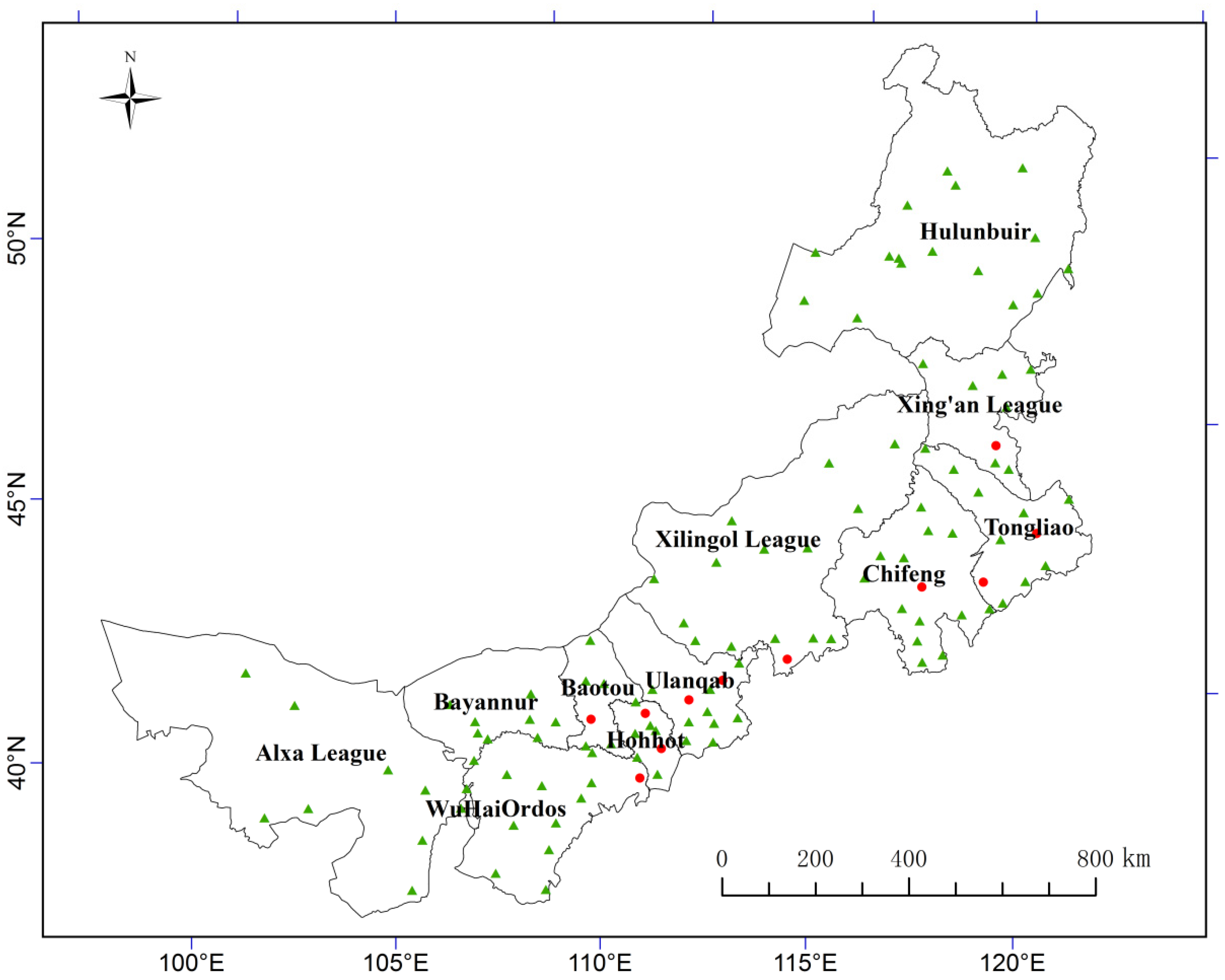
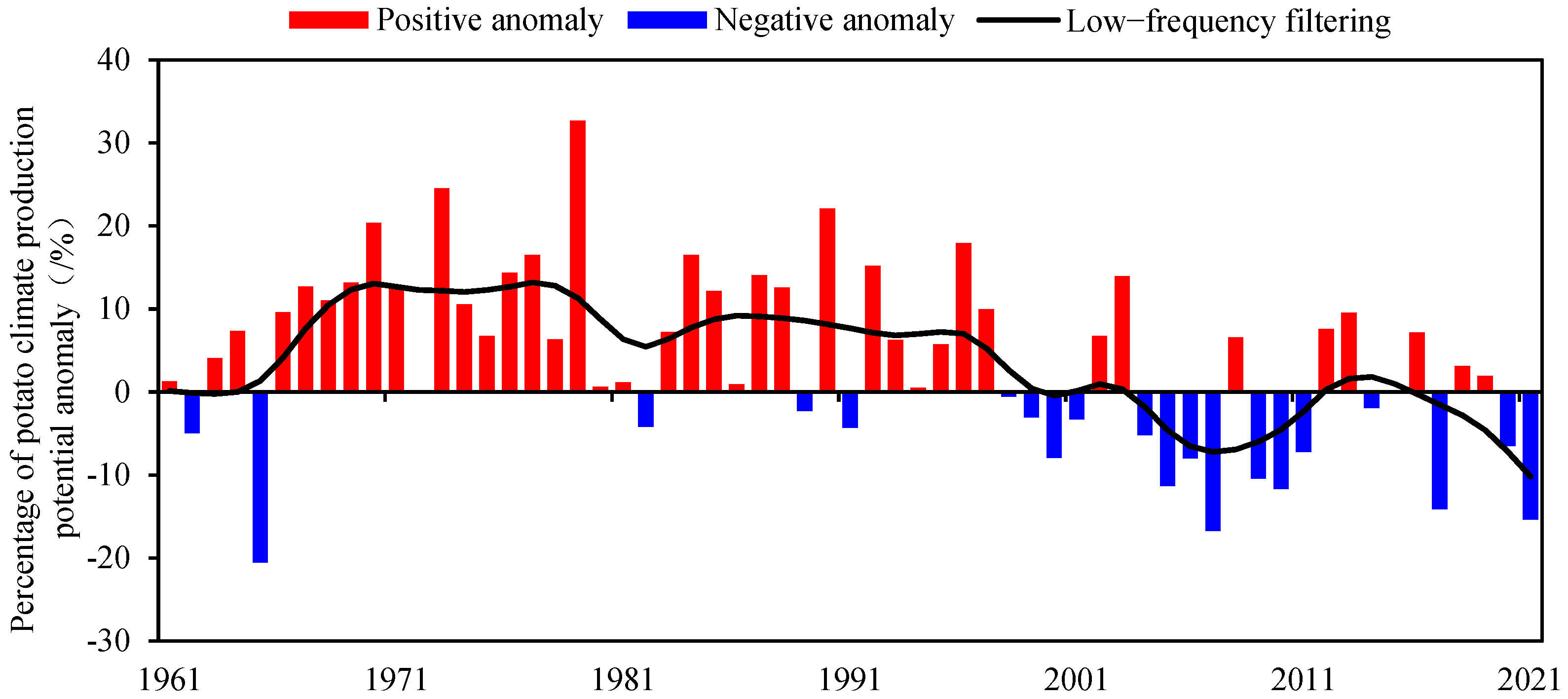




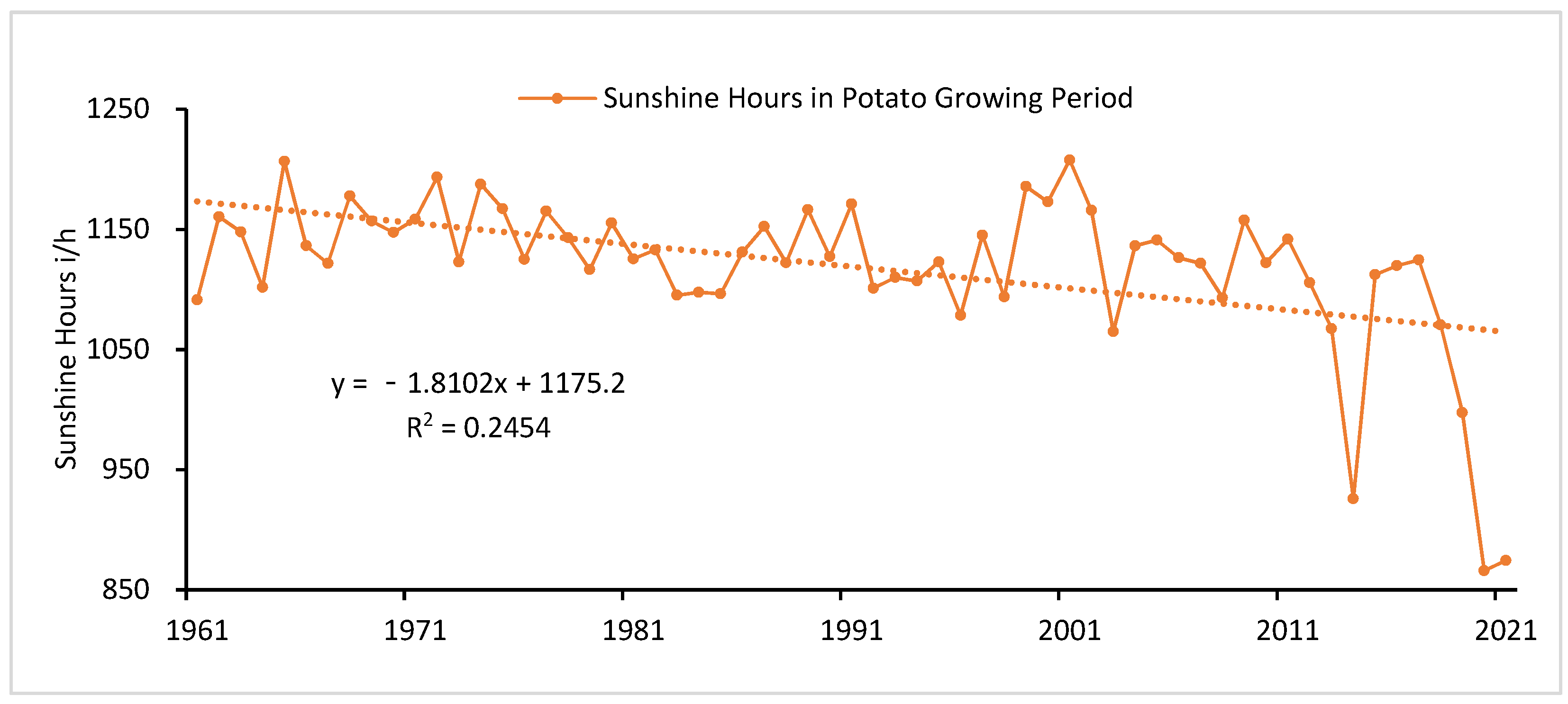
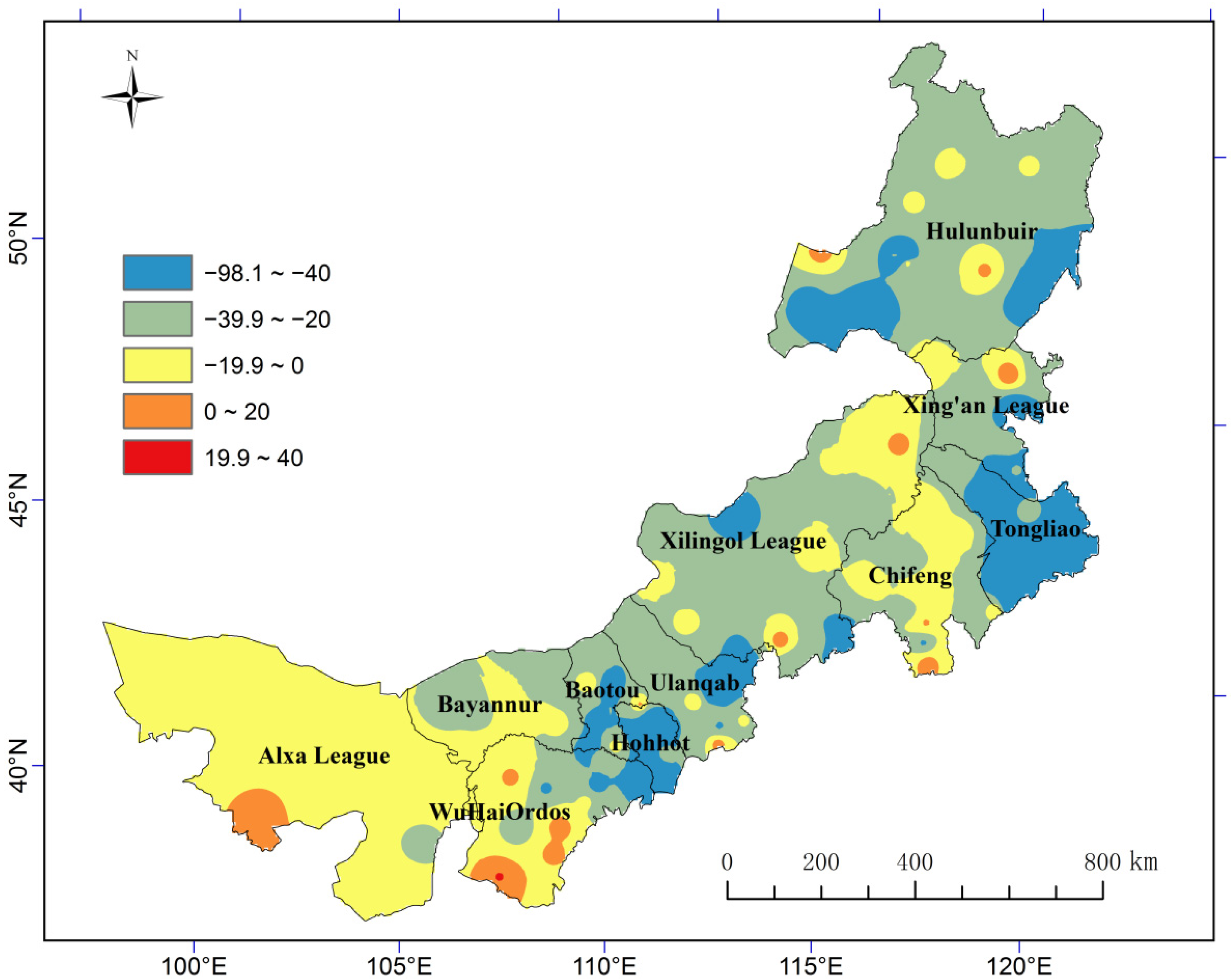


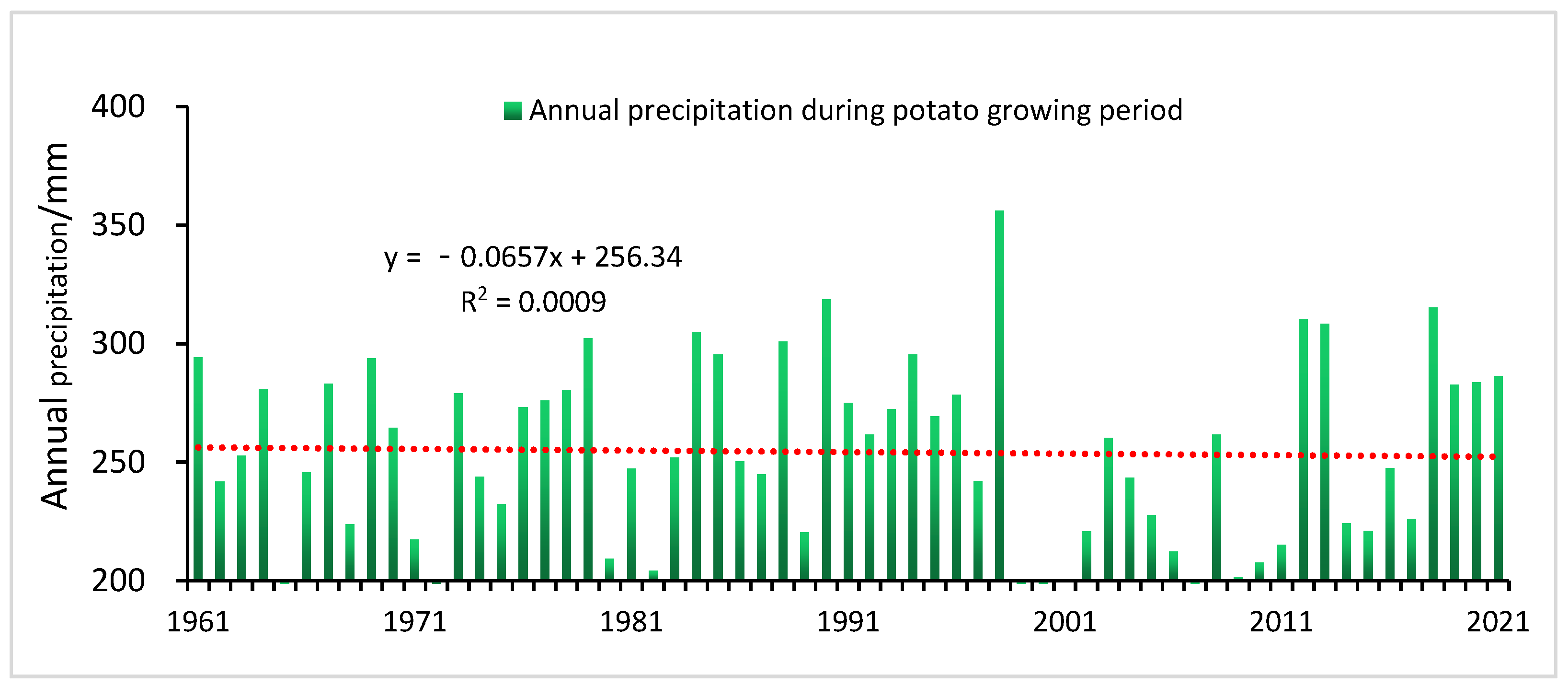

| Growth Period | T1 | T2 | T0 |
|---|---|---|---|
| Sowing–emergence | 5.0 | 29.0 | 14.0 |
| Emergence–branch | 9.0 | 32.0 | 18.3 |
| Branch–inflorescence | 10.0 | 30.0 | 19.5 |
| Inflorescence–bloom | 10.0 | 30.0 | 19.3 |
| Flowering–harvestable | 10.0 | 29.0 | 18.0 |
| Full reproductive period | 5.0 | 32.0 | 17.8 |
Publisher’s Note: MDPI stays neutral with regard to jurisdictional claims in published maps and institutional affiliations. |
© 2022 by the authors. Licensee MDPI, Basel, Switzerland. This article is an open access article distributed under the terms and conditions of the Creative Commons Attribution (CC BY) license (https://creativecommons.org/licenses/by/4.0/).
Share and Cite
Yang, L.-T.; Zhao, J.-F.; Jiang, X.-P.; Wang, S.; Li, L.-H.; Xie, H.-F. Effects of Climate Change on the Climatic Production Potential of Potatoes in Inner Mongolia, China. Sustainability 2022, 14, 7836. https://doi.org/10.3390/su14137836
Yang L-T, Zhao J-F, Jiang X-P, Wang S, Li L-H, Xie H-F. Effects of Climate Change on the Climatic Production Potential of Potatoes in Inner Mongolia, China. Sustainability. 2022; 14(13):7836. https://doi.org/10.3390/su14137836
Chicago/Turabian StyleYang, Li-Tao, Jun-Fang Zhao, Xiang-Ping Jiang, Sheng Wang, Lin-Hui Li, and Hong-Fei Xie. 2022. "Effects of Climate Change on the Climatic Production Potential of Potatoes in Inner Mongolia, China" Sustainability 14, no. 13: 7836. https://doi.org/10.3390/su14137836
APA StyleYang, L.-T., Zhao, J.-F., Jiang, X.-P., Wang, S., Li, L.-H., & Xie, H.-F. (2022). Effects of Climate Change on the Climatic Production Potential of Potatoes in Inner Mongolia, China. Sustainability, 14(13), 7836. https://doi.org/10.3390/su14137836






